Unit 1 Business and The Business Environment
VerifiedAdded on 2023/01/06
|16
|4309
|42
AI Summary
Contribute Materials
Your contribution can guide someone’s learning journey. Share your
documents today.

Unit 1- Business and The
Business Environment
Business Environment
Secure Best Marks with AI Grader
Need help grading? Try our AI Grader for instant feedback on your assignments.
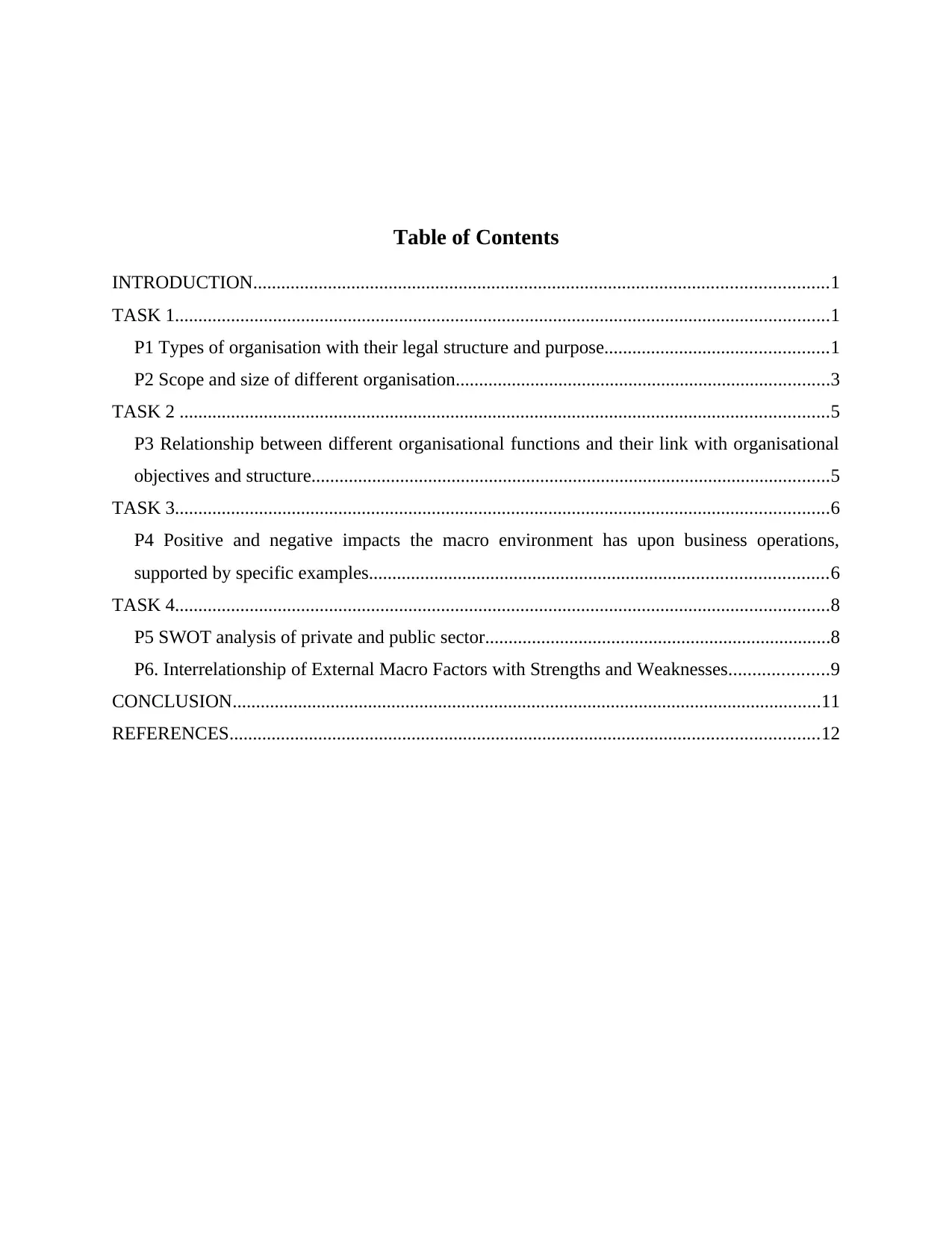
Table of Contents
INTRODUCTION...........................................................................................................................1
TASK 1............................................................................................................................................1
P1 Types of organisation with their legal structure and purpose................................................1
P2 Scope and size of different organisation................................................................................3
TASK 2 ...........................................................................................................................................5
P3 Relationship between different organisational functions and their link with organisational
objectives and structure...............................................................................................................5
TASK 3............................................................................................................................................6
P4 Positive and negative impacts the macro environment has upon business operations,
supported by specific examples..................................................................................................6
TASK 4............................................................................................................................................8
P5 SWOT analysis of private and public sector..........................................................................8
P6. Interrelationship of External Macro Factors with Strengths and Weaknesses.....................9
CONCLUSION..............................................................................................................................11
REFERENCES..............................................................................................................................12
INTRODUCTION...........................................................................................................................1
TASK 1............................................................................................................................................1
P1 Types of organisation with their legal structure and purpose................................................1
P2 Scope and size of different organisation................................................................................3
TASK 2 ...........................................................................................................................................5
P3 Relationship between different organisational functions and their link with organisational
objectives and structure...............................................................................................................5
TASK 3............................................................................................................................................6
P4 Positive and negative impacts the macro environment has upon business operations,
supported by specific examples..................................................................................................6
TASK 4............................................................................................................................................8
P5 SWOT analysis of private and public sector..........................................................................8
P6. Interrelationship of External Macro Factors with Strengths and Weaknesses.....................9
CONCLUSION..............................................................................................................................11
REFERENCES..............................................................................................................................12
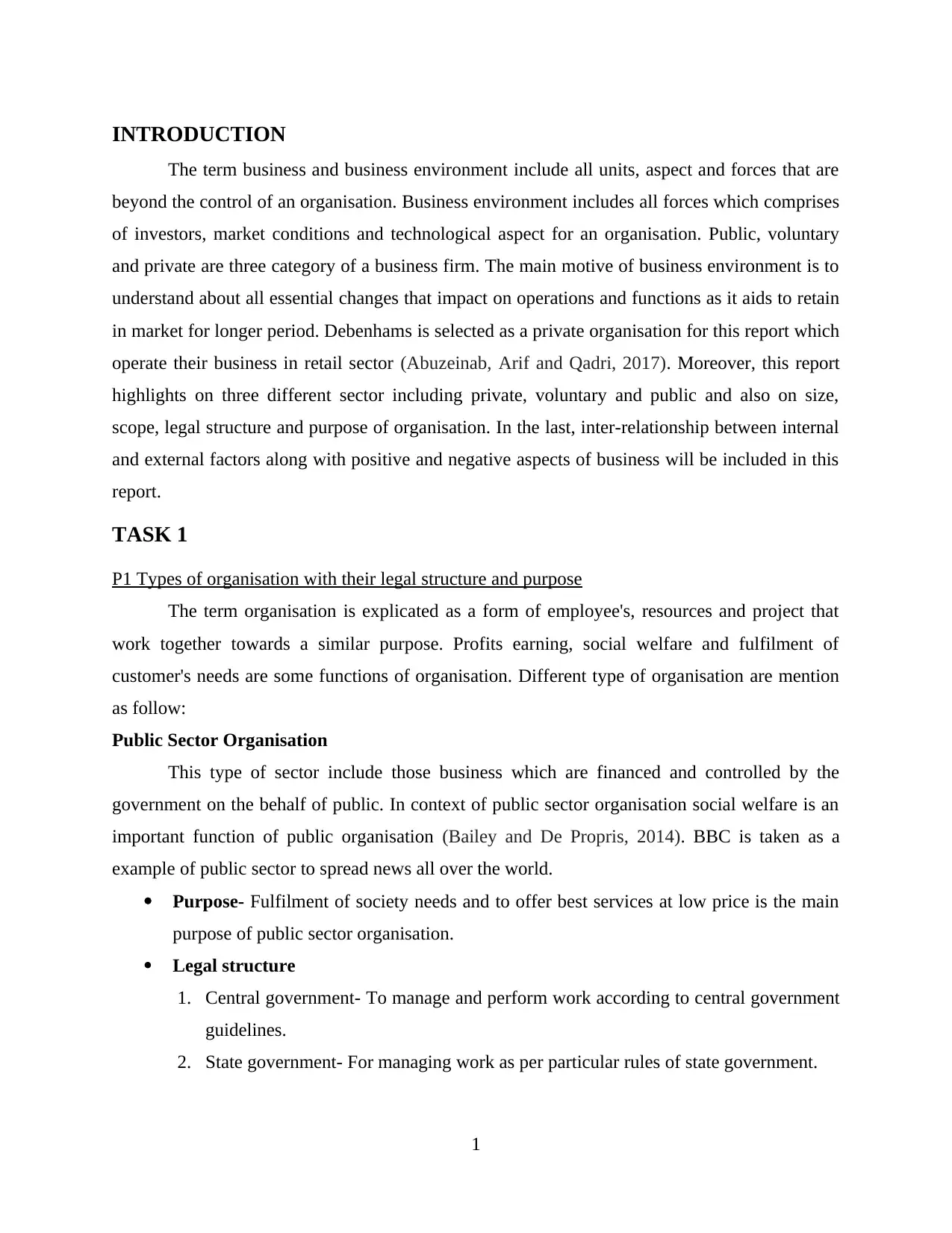
INTRODUCTION
The term business and business environment include all units, aspect and forces that are
beyond the control of an organisation. Business environment includes all forces which comprises
of investors, market conditions and technological aspect for an organisation. Public, voluntary
and private are three category of a business firm. The main motive of business environment is to
understand about all essential changes that impact on operations and functions as it aids to retain
in market for longer period. Debenhams is selected as a private organisation for this report which
operate their business in retail sector (Abuzeinab, Arif and Qadri, 2017). Moreover, this report
highlights on three different sector including private, voluntary and public and also on size,
scope, legal structure and purpose of organisation. In the last, inter-relationship between internal
and external factors along with positive and negative aspects of business will be included in this
report.
TASK 1
P1 Types of organisation with their legal structure and purpose
The term organisation is explicated as a form of employee's, resources and project that
work together towards a similar purpose. Profits earning, social welfare and fulfilment of
customer's needs are some functions of organisation. Different type of organisation are mention
as follow:
Public Sector Organisation
This type of sector include those business which are financed and controlled by the
government on the behalf of public. In context of public sector organisation social welfare is an
important function of public organisation (Bailey and De Propris, 2014). BBC is taken as a
example of public sector to spread news all over the world.
Purpose- Fulfilment of society needs and to offer best services at low price is the main
purpose of public sector organisation.
Legal structure
1. Central government- To manage and perform work according to central government
guidelines.
2. State government- For managing work as per particular rules of state government.
1
The term business and business environment include all units, aspect and forces that are
beyond the control of an organisation. Business environment includes all forces which comprises
of investors, market conditions and technological aspect for an organisation. Public, voluntary
and private are three category of a business firm. The main motive of business environment is to
understand about all essential changes that impact on operations and functions as it aids to retain
in market for longer period. Debenhams is selected as a private organisation for this report which
operate their business in retail sector (Abuzeinab, Arif and Qadri, 2017). Moreover, this report
highlights on three different sector including private, voluntary and public and also on size,
scope, legal structure and purpose of organisation. In the last, inter-relationship between internal
and external factors along with positive and negative aspects of business will be included in this
report.
TASK 1
P1 Types of organisation with their legal structure and purpose
The term organisation is explicated as a form of employee's, resources and project that
work together towards a similar purpose. Profits earning, social welfare and fulfilment of
customer's needs are some functions of organisation. Different type of organisation are mention
as follow:
Public Sector Organisation
This type of sector include those business which are financed and controlled by the
government on the behalf of public. In context of public sector organisation social welfare is an
important function of public organisation (Bailey and De Propris, 2014). BBC is taken as a
example of public sector to spread news all over the world.
Purpose- Fulfilment of society needs and to offer best services at low price is the main
purpose of public sector organisation.
Legal structure
1. Central government- To manage and perform work according to central government
guidelines.
2. State government- For managing work as per particular rules of state government.
1
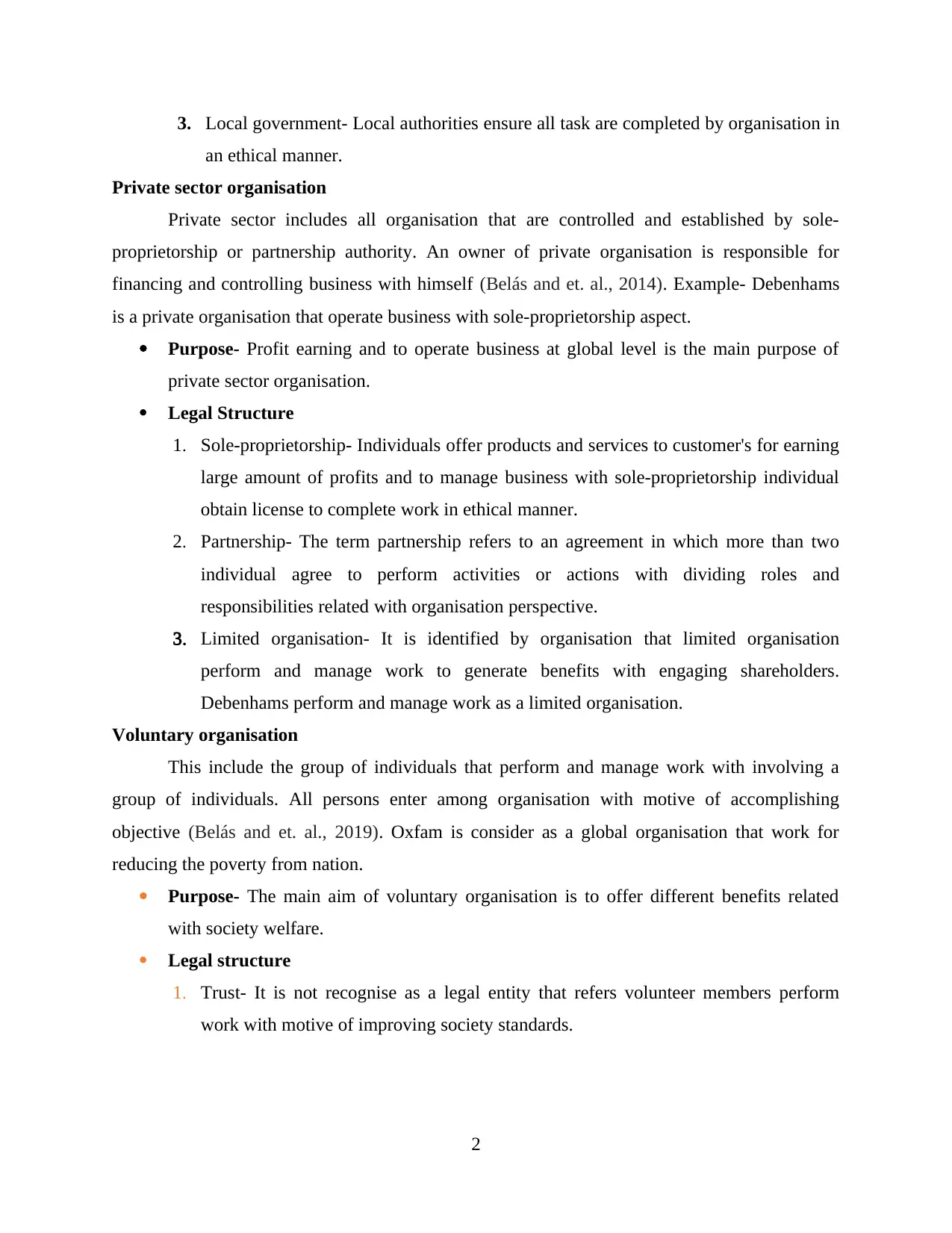
3. Local government- Local authorities ensure all task are completed by organisation in
an ethical manner.
Private sector organisation
Private sector includes all organisation that are controlled and established by sole-
proprietorship or partnership authority. An owner of private organisation is responsible for
financing and controlling business with himself (Belás and et. al., 2014). Example- Debenhams
is a private organisation that operate business with sole-proprietorship aspect.
Purpose- Profit earning and to operate business at global level is the main purpose of
private sector organisation.
Legal Structure
1. Sole-proprietorship- Individuals offer products and services to customer's for earning
large amount of profits and to manage business with sole-proprietorship individual
obtain license to complete work in ethical manner.
2. Partnership- The term partnership refers to an agreement in which more than two
individual agree to perform activities or actions with dividing roles and
responsibilities related with organisation perspective.
3. Limited organisation- It is identified by organisation that limited organisation
perform and manage work to generate benefits with engaging shareholders.
Debenhams perform and manage work as a limited organisation.
Voluntary organisation
This include the group of individuals that perform and manage work with involving a
group of individuals. All persons enter among organisation with motive of accomplishing
objective (Belás and et. al., 2019). Oxfam is consider as a global organisation that work for
reducing the poverty from nation.
Purpose- The main aim of voluntary organisation is to offer different benefits related
with society welfare.
Legal structure
1. Trust- It is not recognise as a legal entity that refers volunteer members perform
work with motive of improving society standards.
2
an ethical manner.
Private sector organisation
Private sector includes all organisation that are controlled and established by sole-
proprietorship or partnership authority. An owner of private organisation is responsible for
financing and controlling business with himself (Belás and et. al., 2014). Example- Debenhams
is a private organisation that operate business with sole-proprietorship aspect.
Purpose- Profit earning and to operate business at global level is the main purpose of
private sector organisation.
Legal Structure
1. Sole-proprietorship- Individuals offer products and services to customer's for earning
large amount of profits and to manage business with sole-proprietorship individual
obtain license to complete work in ethical manner.
2. Partnership- The term partnership refers to an agreement in which more than two
individual agree to perform activities or actions with dividing roles and
responsibilities related with organisation perspective.
3. Limited organisation- It is identified by organisation that limited organisation
perform and manage work to generate benefits with engaging shareholders.
Debenhams perform and manage work as a limited organisation.
Voluntary organisation
This include the group of individuals that perform and manage work with involving a
group of individuals. All persons enter among organisation with motive of accomplishing
objective (Belás and et. al., 2019). Oxfam is consider as a global organisation that work for
reducing the poverty from nation.
Purpose- The main aim of voluntary organisation is to offer different benefits related
with society welfare.
Legal structure
1. Trust- It is not recognise as a legal entity that refers volunteer members perform
work with motive of improving society standards.
2
Secure Best Marks with AI Grader
Need help grading? Try our AI Grader for instant feedback on your assignments.
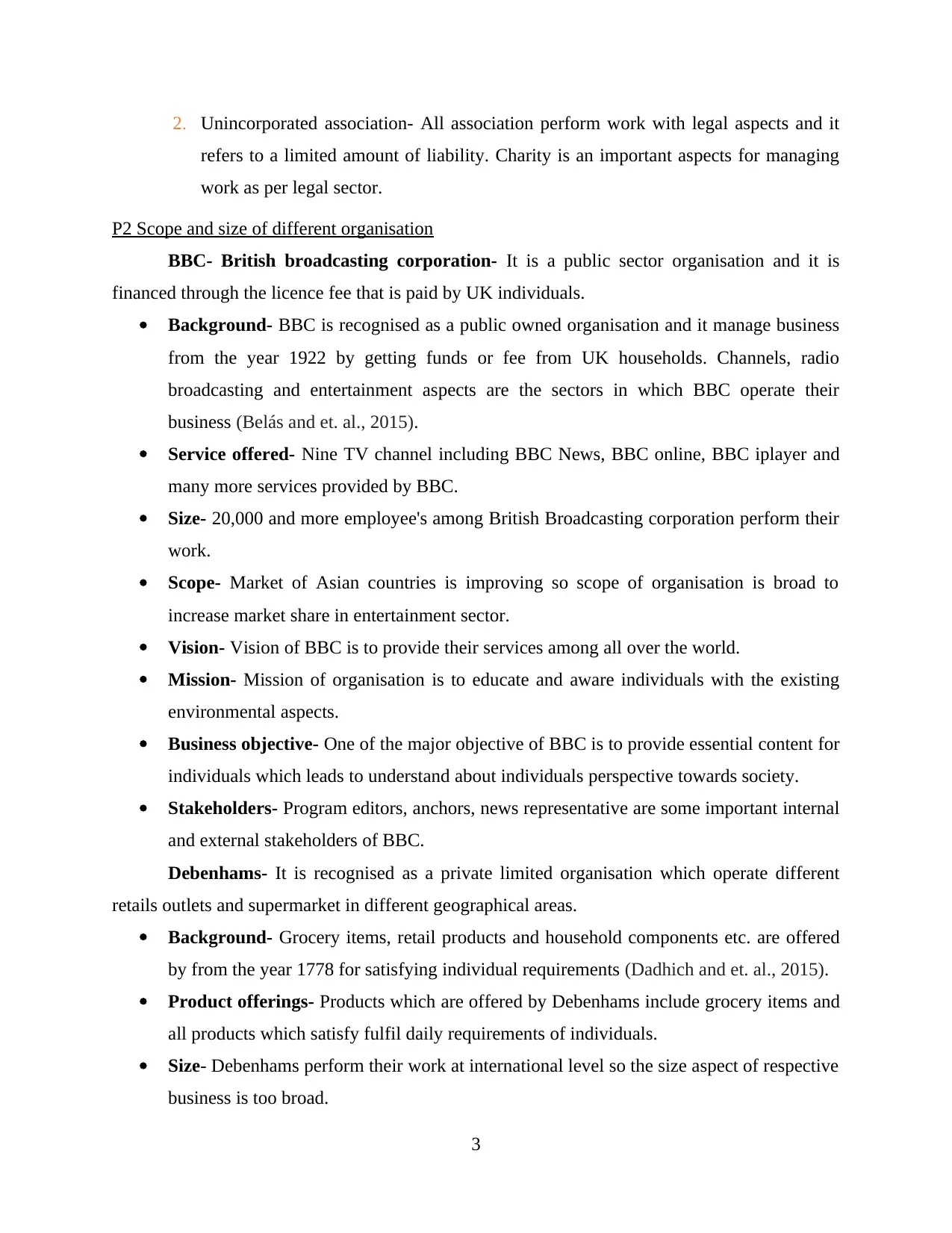
2. Unincorporated association- All association perform work with legal aspects and it
refers to a limited amount of liability. Charity is an important aspects for managing
work as per legal sector.
P2 Scope and size of different organisation
BBC- British broadcasting corporation- It is a public sector organisation and it is
financed through the licence fee that is paid by UK individuals.
Background- BBC is recognised as a public owned organisation and it manage business
from the year 1922 by getting funds or fee from UK households. Channels, radio
broadcasting and entertainment aspects are the sectors in which BBC operate their
business (Belás and et. al., 2015).
Service offered- Nine TV channel including BBC News, BBC online, BBC iplayer and
many more services provided by BBC.
Size- 20,000 and more employee's among British Broadcasting corporation perform their
work.
Scope- Market of Asian countries is improving so scope of organisation is broad to
increase market share in entertainment sector.
Vision- Vision of BBC is to provide their services among all over the world.
Mission- Mission of organisation is to educate and aware individuals with the existing
environmental aspects.
Business objective- One of the major objective of BBC is to provide essential content for
individuals which leads to understand about individuals perspective towards society.
Stakeholders- Program editors, anchors, news representative are some important internal
and external stakeholders of BBC.
Debenhams- It is recognised as a private limited organisation which operate different
retails outlets and supermarket in different geographical areas.
Background- Grocery items, retail products and household components etc. are offered
by from the year 1778 for satisfying individual requirements (Dadhich and et. al., 2015).
Product offerings- Products which are offered by Debenhams include grocery items and
all products which satisfy fulfil daily requirements of individuals.
Size- Debenhams perform their work at international level so the size aspect of respective
business is too broad.
3
refers to a limited amount of liability. Charity is an important aspects for managing
work as per legal sector.
P2 Scope and size of different organisation
BBC- British broadcasting corporation- It is a public sector organisation and it is
financed through the licence fee that is paid by UK individuals.
Background- BBC is recognised as a public owned organisation and it manage business
from the year 1922 by getting funds or fee from UK households. Channels, radio
broadcasting and entertainment aspects are the sectors in which BBC operate their
business (Belás and et. al., 2015).
Service offered- Nine TV channel including BBC News, BBC online, BBC iplayer and
many more services provided by BBC.
Size- 20,000 and more employee's among British Broadcasting corporation perform their
work.
Scope- Market of Asian countries is improving so scope of organisation is broad to
increase market share in entertainment sector.
Vision- Vision of BBC is to provide their services among all over the world.
Mission- Mission of organisation is to educate and aware individuals with the existing
environmental aspects.
Business objective- One of the major objective of BBC is to provide essential content for
individuals which leads to understand about individuals perspective towards society.
Stakeholders- Program editors, anchors, news representative are some important internal
and external stakeholders of BBC.
Debenhams- It is recognised as a private limited organisation which operate different
retails outlets and supermarket in different geographical areas.
Background- Grocery items, retail products and household components etc. are offered
by from the year 1778 for satisfying individual requirements (Dadhich and et. al., 2015).
Product offerings- Products which are offered by Debenhams include grocery items and
all products which satisfy fulfil daily requirements of individuals.
Size- Debenhams perform their work at international level so the size aspect of respective
business is too broad.
3
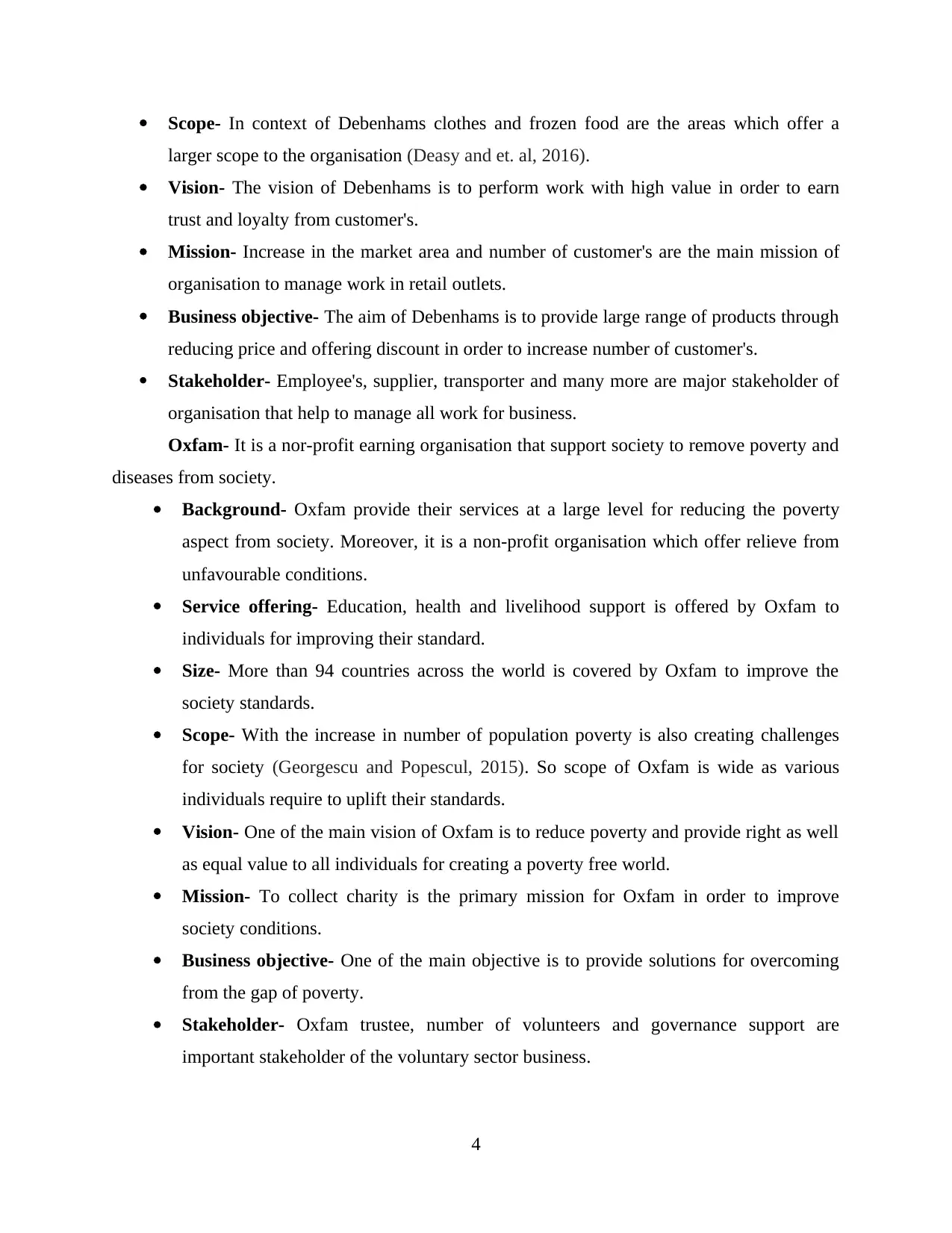
Scope- In context of Debenhams clothes and frozen food are the areas which offer a
larger scope to the organisation (Deasy and et. al, 2016).
Vision- The vision of Debenhams is to perform work with high value in order to earn
trust and loyalty from customer's.
Mission- Increase in the market area and number of customer's are the main mission of
organisation to manage work in retail outlets.
Business objective- The aim of Debenhams is to provide large range of products through
reducing price and offering discount in order to increase number of customer's.
Stakeholder- Employee's, supplier, transporter and many more are major stakeholder of
organisation that help to manage all work for business.
Oxfam- It is a nor-profit earning organisation that support society to remove poverty and
diseases from society.
Background- Oxfam provide their services at a large level for reducing the poverty
aspect from society. Moreover, it is a non-profit organisation which offer relieve from
unfavourable conditions.
Service offering- Education, health and livelihood support is offered by Oxfam to
individuals for improving their standard.
Size- More than 94 countries across the world is covered by Oxfam to improve the
society standards.
Scope- With the increase in number of population poverty is also creating challenges
for society (Georgescu and Popescul, 2015). So scope of Oxfam is wide as various
individuals require to uplift their standards.
Vision- One of the main vision of Oxfam is to reduce poverty and provide right as well
as equal value to all individuals for creating a poverty free world.
Mission- To collect charity is the primary mission for Oxfam in order to improve
society conditions.
Business objective- One of the main objective is to provide solutions for overcoming
from the gap of poverty.
Stakeholder- Oxfam trustee, number of volunteers and governance support are
important stakeholder of the voluntary sector business.
4
larger scope to the organisation (Deasy and et. al, 2016).
Vision- The vision of Debenhams is to perform work with high value in order to earn
trust and loyalty from customer's.
Mission- Increase in the market area and number of customer's are the main mission of
organisation to manage work in retail outlets.
Business objective- The aim of Debenhams is to provide large range of products through
reducing price and offering discount in order to increase number of customer's.
Stakeholder- Employee's, supplier, transporter and many more are major stakeholder of
organisation that help to manage all work for business.
Oxfam- It is a nor-profit earning organisation that support society to remove poverty and
diseases from society.
Background- Oxfam provide their services at a large level for reducing the poverty
aspect from society. Moreover, it is a non-profit organisation which offer relieve from
unfavourable conditions.
Service offering- Education, health and livelihood support is offered by Oxfam to
individuals for improving their standard.
Size- More than 94 countries across the world is covered by Oxfam to improve the
society standards.
Scope- With the increase in number of population poverty is also creating challenges
for society (Georgescu and Popescul, 2015). So scope of Oxfam is wide as various
individuals require to uplift their standards.
Vision- One of the main vision of Oxfam is to reduce poverty and provide right as well
as equal value to all individuals for creating a poverty free world.
Mission- To collect charity is the primary mission for Oxfam in order to improve
society conditions.
Business objective- One of the main objective is to provide solutions for overcoming
from the gap of poverty.
Stakeholder- Oxfam trustee, number of volunteers and governance support are
important stakeholder of the voluntary sector business.
4
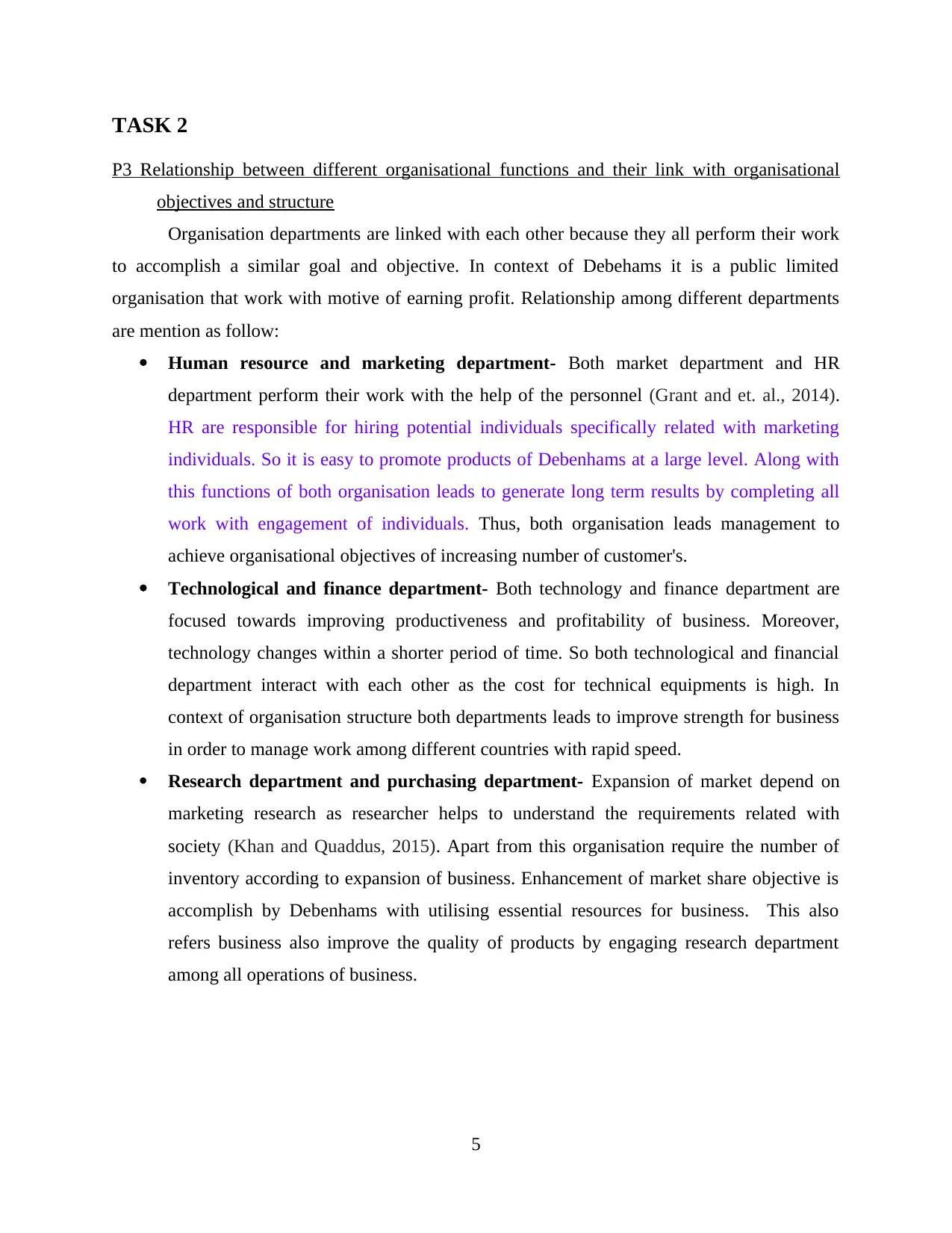
TASK 2
P3 Relationship between different organisational functions and their link with organisational
objectives and structure
Organisation departments are linked with each other because they all perform their work
to accomplish a similar goal and objective. In context of Debehams it is a public limited
organisation that work with motive of earning profit. Relationship among different departments
are mention as follow:
Human resource and marketing department- Both market department and HR
department perform their work with the help of the personnel (Grant and et. al., 2014).
HR are responsible for hiring potential individuals specifically related with marketing
individuals. So it is easy to promote products of Debenhams at a large level. Along with
this functions of both organisation leads to generate long term results by completing all
work with engagement of individuals. Thus, both organisation leads management to
achieve organisational objectives of increasing number of customer's.
Technological and finance department- Both technology and finance department are
focused towards improving productiveness and profitability of business. Moreover,
technology changes within a shorter period of time. So both technological and financial
department interact with each other as the cost for technical equipments is high. In
context of organisation structure both departments leads to improve strength for business
in order to manage work among different countries with rapid speed.
Research department and purchasing department- Expansion of market depend on
marketing research as researcher helps to understand the requirements related with
society (Khan and Quaddus, 2015). Apart from this organisation require the number of
inventory according to expansion of business. Enhancement of market share objective is
accomplish by Debenhams with utilising essential resources for business. This also
refers business also improve the quality of products by engaging research department
among all operations of business.
5
P3 Relationship between different organisational functions and their link with organisational
objectives and structure
Organisation departments are linked with each other because they all perform their work
to accomplish a similar goal and objective. In context of Debehams it is a public limited
organisation that work with motive of earning profit. Relationship among different departments
are mention as follow:
Human resource and marketing department- Both market department and HR
department perform their work with the help of the personnel (Grant and et. al., 2014).
HR are responsible for hiring potential individuals specifically related with marketing
individuals. So it is easy to promote products of Debenhams at a large level. Along with
this functions of both organisation leads to generate long term results by completing all
work with engagement of individuals. Thus, both organisation leads management to
achieve organisational objectives of increasing number of customer's.
Technological and finance department- Both technology and finance department are
focused towards improving productiveness and profitability of business. Moreover,
technology changes within a shorter period of time. So both technological and financial
department interact with each other as the cost for technical equipments is high. In
context of organisation structure both departments leads to improve strength for business
in order to manage work among different countries with rapid speed.
Research department and purchasing department- Expansion of market depend on
marketing research as researcher helps to understand the requirements related with
society (Khan and Quaddus, 2015). Apart from this organisation require the number of
inventory according to expansion of business. Enhancement of market share objective is
accomplish by Debenhams with utilising essential resources for business. This also
refers business also improve the quality of products by engaging research department
among all operations of business.
5
Paraphrase This Document
Need a fresh take? Get an instant paraphrase of this document with our AI Paraphraser
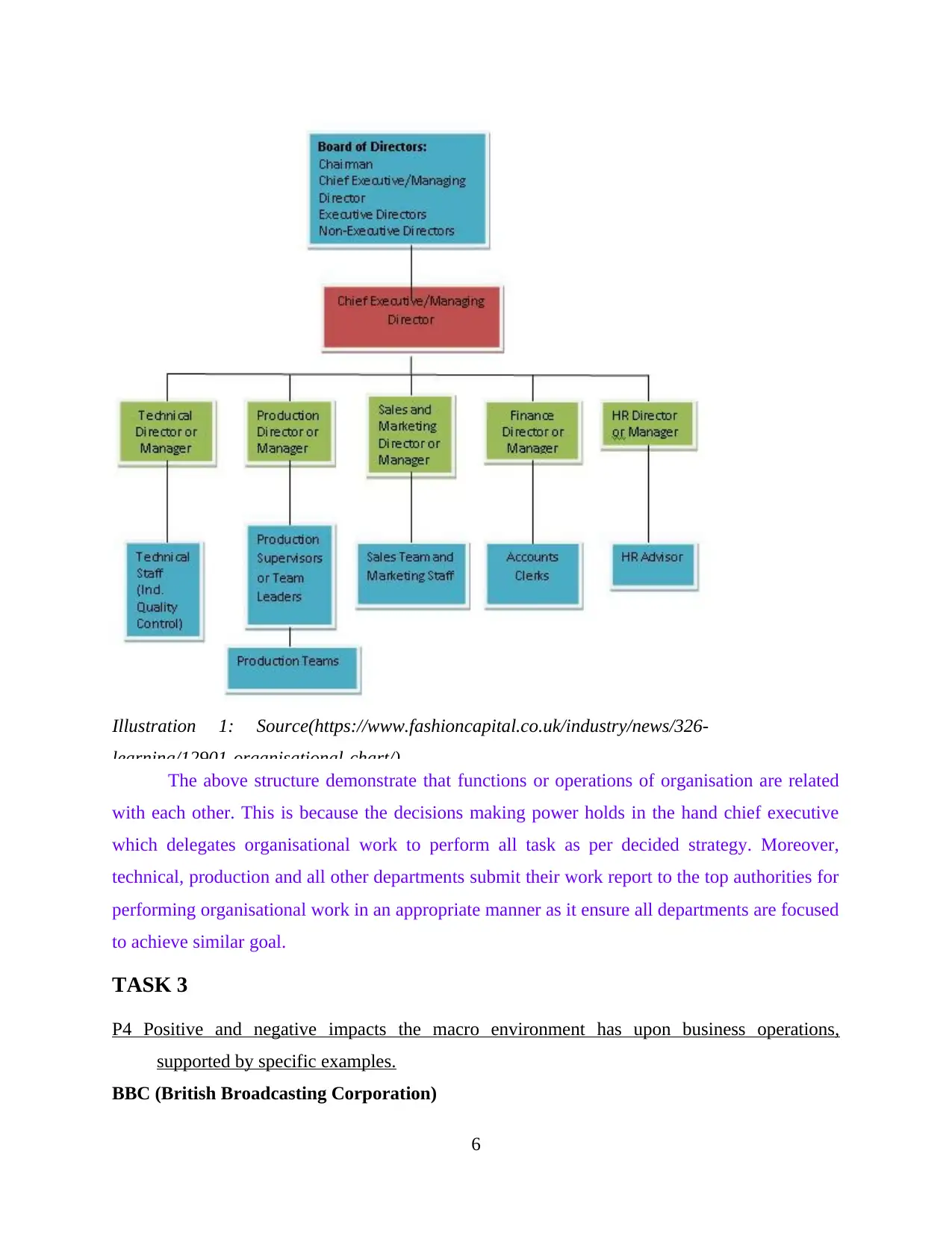
Illustration 1: Source(https://www.fashioncapital.co.uk/industry/news/326-
learning/12901-organisational-chart/)
The above structure demonstrate that functions or operations of organisation are related
with each other. This is because the decisions making power holds in the hand chief executive
which delegates organisational work to perform all task as per decided strategy. Moreover,
technical, production and all other departments submit their work report to the top authorities for
performing organisational work in an appropriate manner as it ensure all departments are focused
to achieve similar goal.
TASK 3
P4 Positive and negative impacts the macro environment has upon business operations,
supported by specific examples.
BBC (British Broadcasting Corporation)
6
learning/12901-organisational-chart/)
The above structure demonstrate that functions or operations of organisation are related
with each other. This is because the decisions making power holds in the hand chief executive
which delegates organisational work to perform all task as per decided strategy. Moreover,
technical, production and all other departments submit their work report to the top authorities for
performing organisational work in an appropriate manner as it ensure all departments are focused
to achieve similar goal.
TASK 3
P4 Positive and negative impacts the macro environment has upon business operations,
supported by specific examples.
BBC (British Broadcasting Corporation)
6
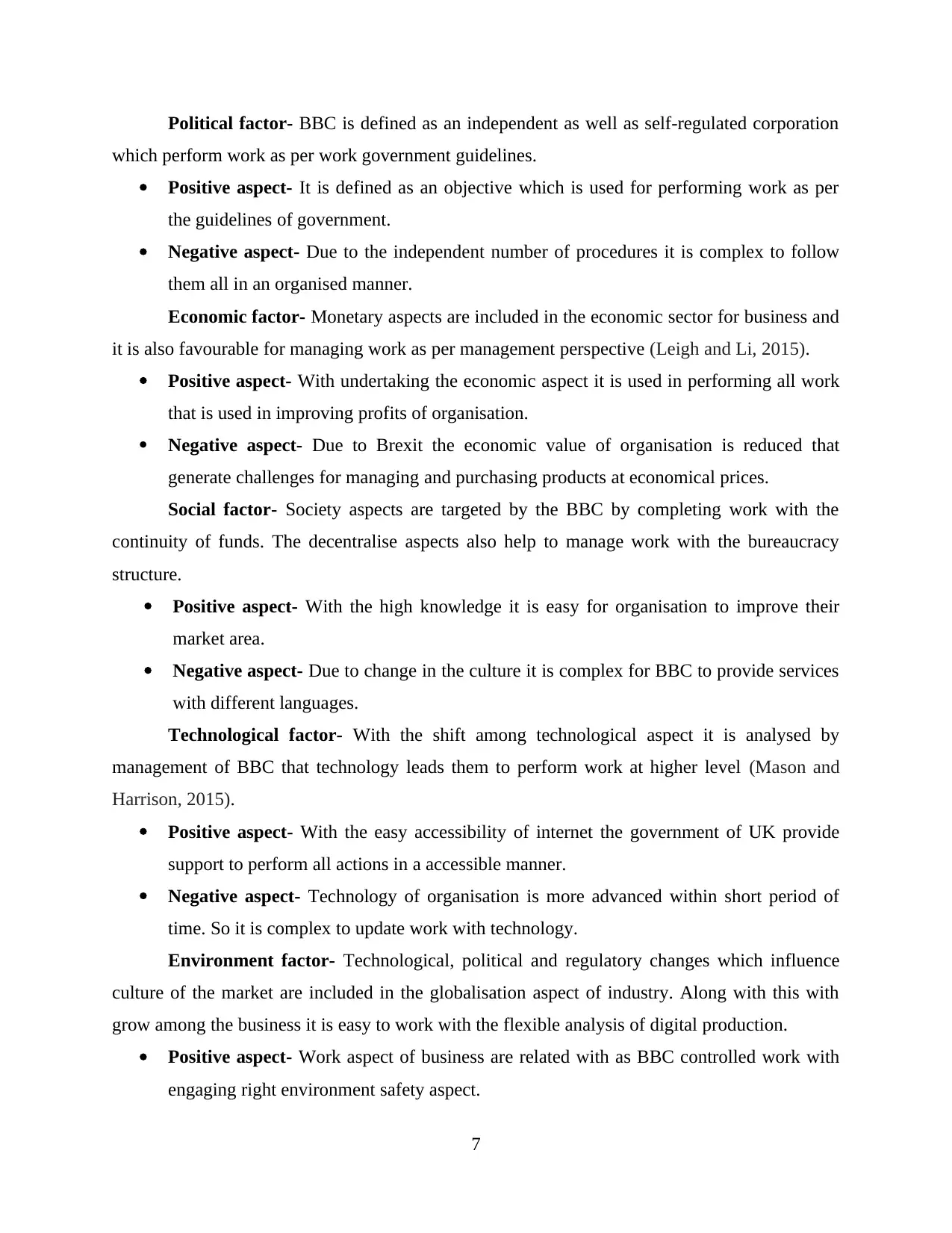
Political factor- BBC is defined as an independent as well as self-regulated corporation
which perform work as per work government guidelines.
Positive aspect- It is defined as an objective which is used for performing work as per
the guidelines of government.
Negative aspect- Due to the independent number of procedures it is complex to follow
them all in an organised manner.
Economic factor- Monetary aspects are included in the economic sector for business and
it is also favourable for managing work as per management perspective (Leigh and Li, 2015).
Positive aspect- With undertaking the economic aspect it is used in performing all work
that is used in improving profits of organisation.
Negative aspect- Due to Brexit the economic value of organisation is reduced that
generate challenges for managing and purchasing products at economical prices.
Social factor- Society aspects are targeted by the BBC by completing work with the
continuity of funds. The decentralise aspects also help to manage work with the bureaucracy
structure.
Positive aspect- With the high knowledge it is easy for organisation to improve their
market area.
Negative aspect- Due to change in the culture it is complex for BBC to provide services
with different languages.
Technological factor- With the shift among technological aspect it is analysed by
management of BBC that technology leads them to perform work at higher level (Mason and
Harrison, 2015).
Positive aspect- With the easy accessibility of internet the government of UK provide
support to perform all actions in a accessible manner.
Negative aspect- Technology of organisation is more advanced within short period of
time. So it is complex to update work with technology.
Environment factor- Technological, political and regulatory changes which influence
culture of the market are included in the globalisation aspect of industry. Along with this with
grow among the business it is easy to work with the flexible analysis of digital production.
Positive aspect- Work aspect of business are related with as BBC controlled work with
engaging right environment safety aspect.
7
which perform work as per work government guidelines.
Positive aspect- It is defined as an objective which is used for performing work as per
the guidelines of government.
Negative aspect- Due to the independent number of procedures it is complex to follow
them all in an organised manner.
Economic factor- Monetary aspects are included in the economic sector for business and
it is also favourable for managing work as per management perspective (Leigh and Li, 2015).
Positive aspect- With undertaking the economic aspect it is used in performing all work
that is used in improving profits of organisation.
Negative aspect- Due to Brexit the economic value of organisation is reduced that
generate challenges for managing and purchasing products at economical prices.
Social factor- Society aspects are targeted by the BBC by completing work with the
continuity of funds. The decentralise aspects also help to manage work with the bureaucracy
structure.
Positive aspect- With the high knowledge it is easy for organisation to improve their
market area.
Negative aspect- Due to change in the culture it is complex for BBC to provide services
with different languages.
Technological factor- With the shift among technological aspect it is analysed by
management of BBC that technology leads them to perform work at higher level (Mason and
Harrison, 2015).
Positive aspect- With the easy accessibility of internet the government of UK provide
support to perform all actions in a accessible manner.
Negative aspect- Technology of organisation is more advanced within short period of
time. So it is complex to update work with technology.
Environment factor- Technological, political and regulatory changes which influence
culture of the market are included in the globalisation aspect of industry. Along with this with
grow among the business it is easy to work with the flexible analysis of digital production.
Positive aspect- Work aspect of business are related with as BBC controlled work with
engaging right environment safety aspect.
7
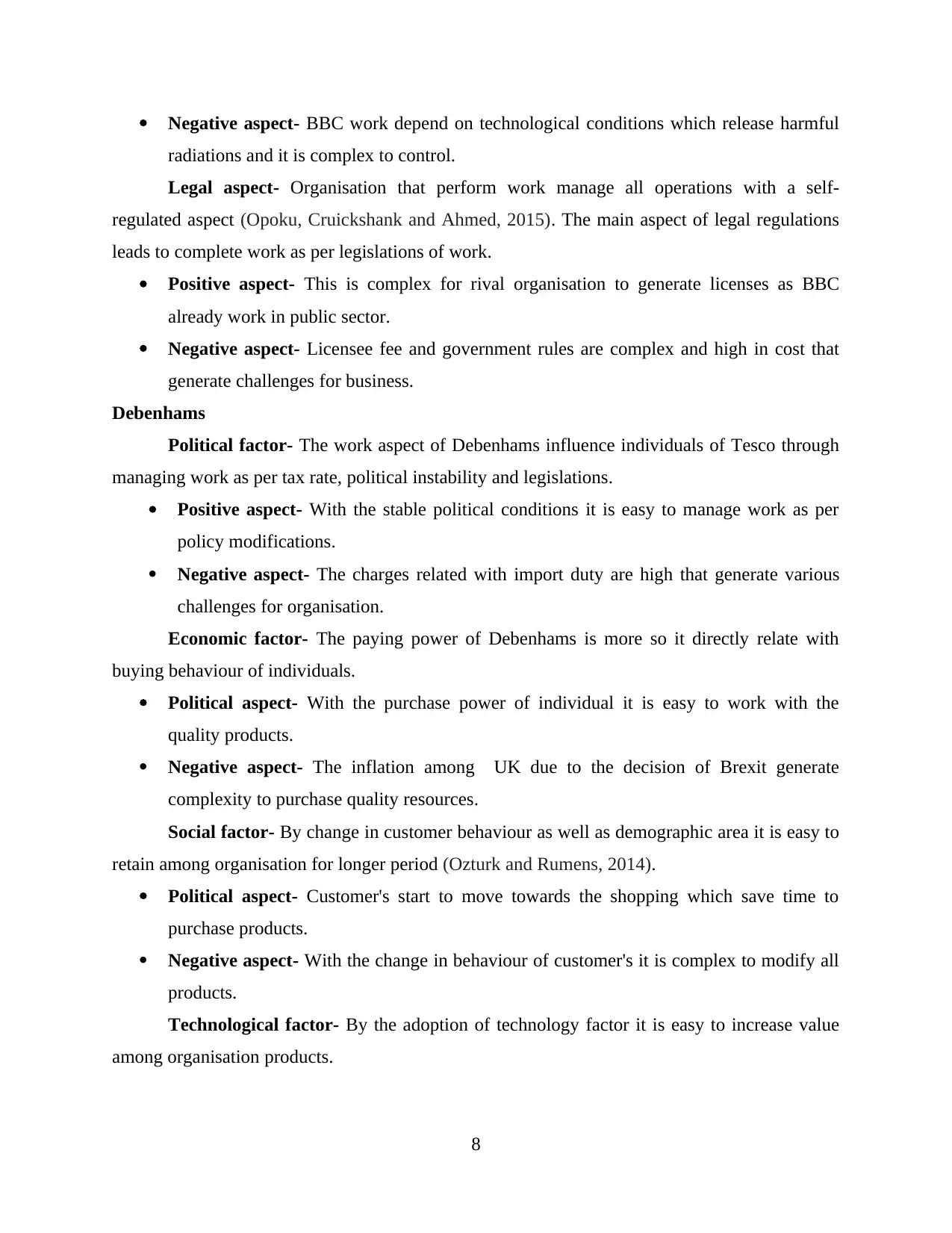
Negative aspect- BBC work depend on technological conditions which release harmful
radiations and it is complex to control.
Legal aspect- Organisation that perform work manage all operations with a self-
regulated aspect (Opoku, Cruickshank and Ahmed, 2015). The main aspect of legal regulations
leads to complete work as per legislations of work.
Positive aspect- This is complex for rival organisation to generate licenses as BBC
already work in public sector.
Negative aspect- Licensee fee and government rules are complex and high in cost that
generate challenges for business.
Debenhams
Political factor- The work aspect of Debenhams influence individuals of Tesco through
managing work as per tax rate, political instability and legislations.
Positive aspect- With the stable political conditions it is easy to manage work as per
policy modifications.
Negative aspect- The charges related with import duty are high that generate various
challenges for organisation.
Economic factor- The paying power of Debenhams is more so it directly relate with
buying behaviour of individuals.
Political aspect- With the purchase power of individual it is easy to work with the
quality products.
Negative aspect- The inflation among UK due to the decision of Brexit generate
complexity to purchase quality resources.
Social factor- By change in customer behaviour as well as demographic area it is easy to
retain among organisation for longer period (Ozturk and Rumens, 2014).
Political aspect- Customer's start to move towards the shopping which save time to
purchase products.
Negative aspect- With the change in behaviour of customer's it is complex to modify all
products.
Technological factor- By the adoption of technology factor it is easy to increase value
among organisation products.
8
radiations and it is complex to control.
Legal aspect- Organisation that perform work manage all operations with a self-
regulated aspect (Opoku, Cruickshank and Ahmed, 2015). The main aspect of legal regulations
leads to complete work as per legislations of work.
Positive aspect- This is complex for rival organisation to generate licenses as BBC
already work in public sector.
Negative aspect- Licensee fee and government rules are complex and high in cost that
generate challenges for business.
Debenhams
Political factor- The work aspect of Debenhams influence individuals of Tesco through
managing work as per tax rate, political instability and legislations.
Positive aspect- With the stable political conditions it is easy to manage work as per
policy modifications.
Negative aspect- The charges related with import duty are high that generate various
challenges for organisation.
Economic factor- The paying power of Debenhams is more so it directly relate with
buying behaviour of individuals.
Political aspect- With the purchase power of individual it is easy to work with the
quality products.
Negative aspect- The inflation among UK due to the decision of Brexit generate
complexity to purchase quality resources.
Social factor- By change in customer behaviour as well as demographic area it is easy to
retain among organisation for longer period (Ozturk and Rumens, 2014).
Political aspect- Customer's start to move towards the shopping which save time to
purchase products.
Negative aspect- With the change in behaviour of customer's it is complex to modify all
products.
Technological factor- By the adoption of technology factor it is easy to increase value
among organisation products.
8
Secure Best Marks with AI Grader
Need help grading? Try our AI Grader for instant feedback on your assignments.

Positive aspect- Online shopping application and home delivery leads management to
engage technology in company functions (Sung and et. al., 2017).
Negative aspect- The process to add technical equipments is high that directly reduce
profits for business.
Legal factor- The business of Debenhams is directly relate with government law such as
consumer protection act is essential to protect the regular aspect for business.
Positive aspect- Debenhams follow all essential rules that prevails customer's to generate
trust among organisation.
Negative aspect- Due to high competition it is complex to perform all work with
environment policies.
TASK 4
P5 SWOT analysis of private and public sector
SWOT analysis of BBC
Strength- It is an oldest broadcaster which provide service at global level. Moreover,
Goodwill and brand image of BBC is valuable that helps to gain competitive edge in market.
Weaknesses- Biased opinion about UK is a major weak point for business and another
one of the biggest weak is the danger of life at war zone and conflict situation.
Opportunities-With emerging market of India the possibility to interview capable
candidates is more and also fashion is an area that constantly update it work as positive point for
business.
Threats- Strong competition with domestic service provider generate complexity for
business. Another, threat is recession and pandemic conditions generate challenges for BBC to
continue service at a large level.
SWOT analysis of Debenham
Strength- Debenhams is recognise as a leading organisation of UK that helps to cover a
large market area and another aspect is wide range of products that improve strength aspects of
Debenhams.
Weaknesses- Debenhams market is totally based on UK so if conflict raised with
individuals than sale of company is directly impacted. Operational process of Debenhams is high
9
engage technology in company functions (Sung and et. al., 2017).
Negative aspect- The process to add technical equipments is high that directly reduce
profits for business.
Legal factor- The business of Debenhams is directly relate with government law such as
consumer protection act is essential to protect the regular aspect for business.
Positive aspect- Debenhams follow all essential rules that prevails customer's to generate
trust among organisation.
Negative aspect- Due to high competition it is complex to perform all work with
environment policies.
TASK 4
P5 SWOT analysis of private and public sector
SWOT analysis of BBC
Strength- It is an oldest broadcaster which provide service at global level. Moreover,
Goodwill and brand image of BBC is valuable that helps to gain competitive edge in market.
Weaknesses- Biased opinion about UK is a major weak point for business and another
one of the biggest weak is the danger of life at war zone and conflict situation.
Opportunities-With emerging market of India the possibility to interview capable
candidates is more and also fashion is an area that constantly update it work as positive point for
business.
Threats- Strong competition with domestic service provider generate complexity for
business. Another, threat is recession and pandemic conditions generate challenges for BBC to
continue service at a large level.
SWOT analysis of Debenham
Strength- Debenhams is recognise as a leading organisation of UK that helps to cover a
large market area and another aspect is wide range of products that improve strength aspects of
Debenhams.
Weaknesses- Debenhams market is totally based on UK so if conflict raised with
individuals than sale of company is directly impacted. Operational process of Debenhams is high
9
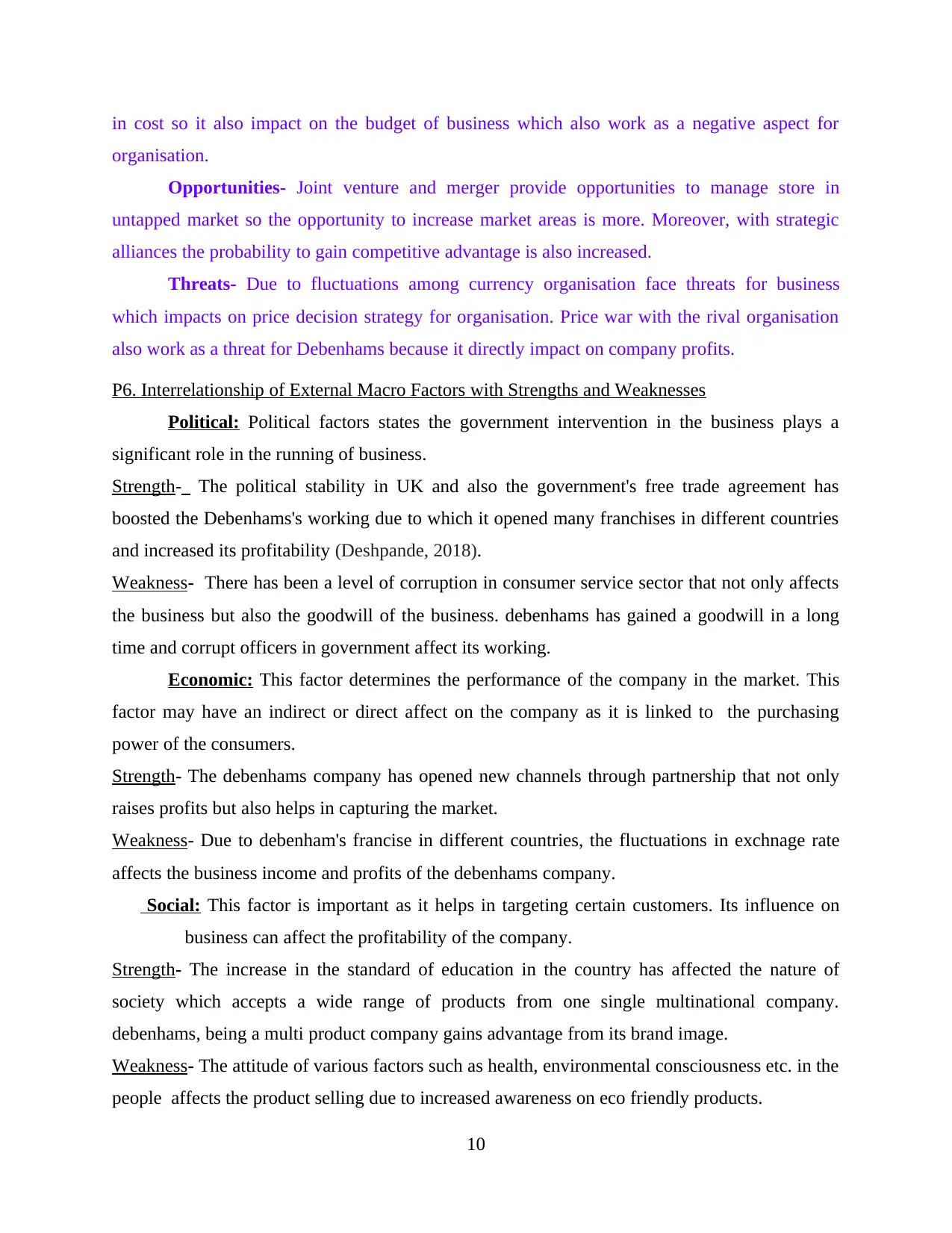
in cost so it also impact on the budget of business which also work as a negative aspect for
organisation.
Opportunities- Joint venture and merger provide opportunities to manage store in
untapped market so the opportunity to increase market areas is more. Moreover, with strategic
alliances the probability to gain competitive advantage is also increased.
Threats- Due to fluctuations among currency organisation face threats for business
which impacts on price decision strategy for organisation. Price war with the rival organisation
also work as a threat for Debenhams because it directly impact on company profits.
P6. Interrelationship of External Macro Factors with Strengths and Weaknesses
Political: Political factors states the government intervention in the business plays a
significant role in the running of business.
Strength- The political stability in UK and also the government's free trade agreement has
boosted the Debenhams's working due to which it opened many franchises in different countries
and increased its profitability (Deshpande, 2018).
Weakness- There has been a level of corruption in consumer service sector that not only affects
the business but also the goodwill of the business. debenhams has gained a goodwill in a long
time and corrupt officers in government affect its working.
Economic: This factor determines the performance of the company in the market. This
factor may have an indirect or direct affect on the company as it is linked to the purchasing
power of the consumers.
Strength- The debenhams company has opened new channels through partnership that not only
raises profits but also helps in capturing the market.
Weakness- Due to debenham's francise in different countries, the fluctuations in exchnage rate
affects the business income and profits of the debenhams company.
Social: This factor is important as it helps in targeting certain customers. Its influence on
business can affect the profitability of the company.
Strength- The increase in the standard of education in the country has affected the nature of
society which accepts a wide range of products from one single multinational company.
debenhams, being a multi product company gains advantage from its brand image.
Weakness- The attitude of various factors such as health, environmental consciousness etc. in the
people affects the product selling due to increased awareness on eco friendly products.
10
organisation.
Opportunities- Joint venture and merger provide opportunities to manage store in
untapped market so the opportunity to increase market areas is more. Moreover, with strategic
alliances the probability to gain competitive advantage is also increased.
Threats- Due to fluctuations among currency organisation face threats for business
which impacts on price decision strategy for organisation. Price war with the rival organisation
also work as a threat for Debenhams because it directly impact on company profits.
P6. Interrelationship of External Macro Factors with Strengths and Weaknesses
Political: Political factors states the government intervention in the business plays a
significant role in the running of business.
Strength- The political stability in UK and also the government's free trade agreement has
boosted the Debenhams's working due to which it opened many franchises in different countries
and increased its profitability (Deshpande, 2018).
Weakness- There has been a level of corruption in consumer service sector that not only affects
the business but also the goodwill of the business. debenhams has gained a goodwill in a long
time and corrupt officers in government affect its working.
Economic: This factor determines the performance of the company in the market. This
factor may have an indirect or direct affect on the company as it is linked to the purchasing
power of the consumers.
Strength- The debenhams company has opened new channels through partnership that not only
raises profits but also helps in capturing the market.
Weakness- Due to debenham's francise in different countries, the fluctuations in exchnage rate
affects the business income and profits of the debenhams company.
Social: This factor is important as it helps in targeting certain customers. Its influence on
business can affect the profitability of the company.
Strength- The increase in the standard of education in the country has affected the nature of
society which accepts a wide range of products from one single multinational company.
debenhams, being a multi product company gains advantage from its brand image.
Weakness- The attitude of various factors such as health, environmental consciousness etc. in the
people affects the product selling due to increased awareness on eco friendly products.
10
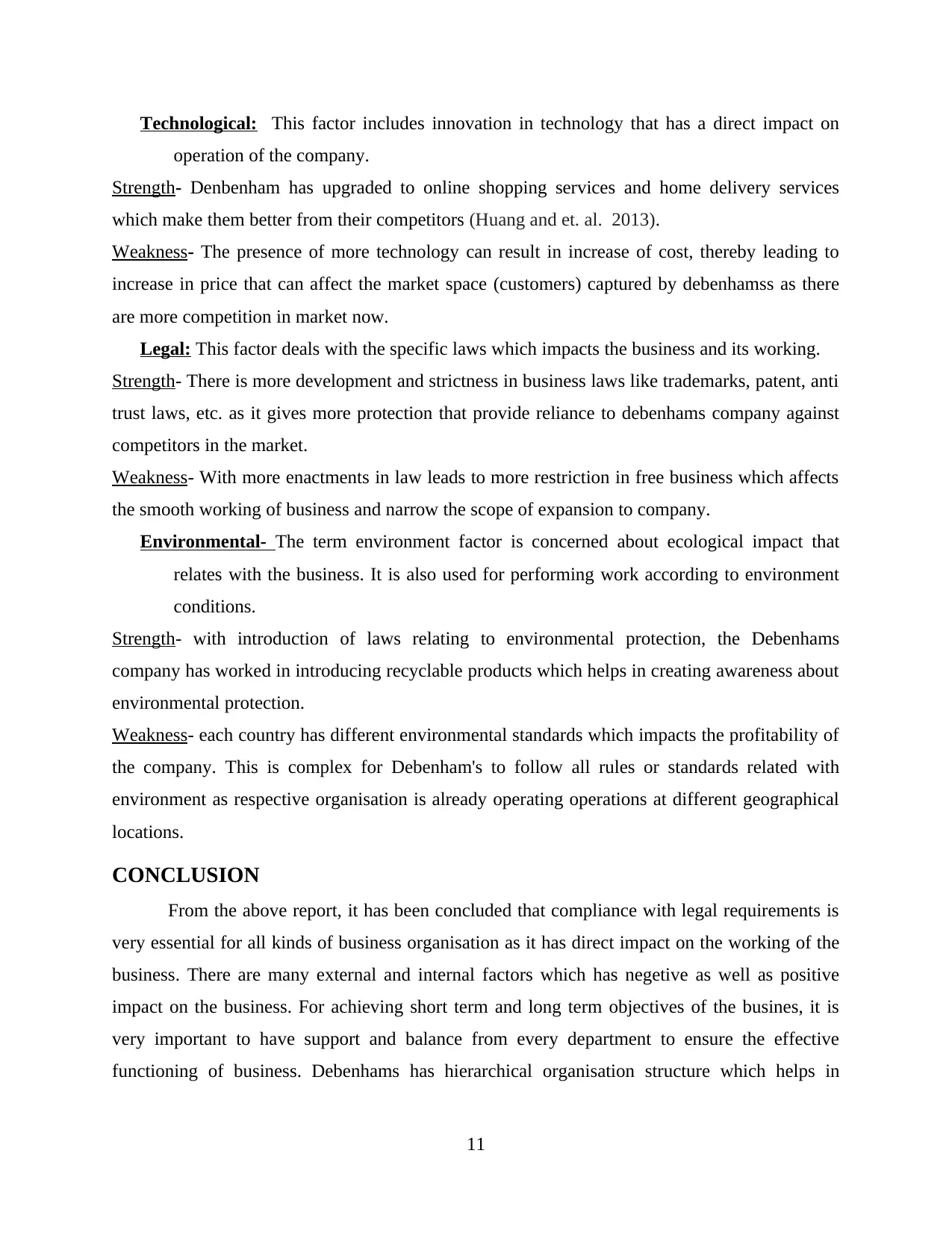
Technological: This factor includes innovation in technology that has a direct impact on
operation of the company.
Strength- Denbenham has upgraded to online shopping services and home delivery services
which make them better from their competitors (Huang and et. al. 2013).
Weakness- The presence of more technology can result in increase of cost, thereby leading to
increase in price that can affect the market space (customers) captured by debenhamss as there
are more competition in market now.
Legal: This factor deals with the specific laws which impacts the business and its working.
Strength- There is more development and strictness in business laws like trademarks, patent, anti
trust laws, etc. as it gives more protection that provide reliance to debenhams company against
competitors in the market.
Weakness- With more enactments in law leads to more restriction in free business which affects
the smooth working of business and narrow the scope of expansion to company.
Environmental- The term environment factor is concerned about ecological impact that
relates with the business. It is also used for performing work according to environment
conditions.
Strength- with introduction of laws relating to environmental protection, the Debenhams
company has worked in introducing recyclable products which helps in creating awareness about
environmental protection.
Weakness- each country has different environmental standards which impacts the profitability of
the company. This is complex for Debenham's to follow all rules or standards related with
environment as respective organisation is already operating operations at different geographical
locations.
CONCLUSION
From the above report, it has been concluded that compliance with legal requirements is
very essential for all kinds of business organisation as it has direct impact on the working of the
business. There are many external and internal factors which has negetive as well as positive
impact on the business. For achieving short term and long term objectives of the busines, it is
very important to have support and balance from every department to ensure the effective
functioning of business. Debenhams has hierarchical organisation structure which helps in
11
operation of the company.
Strength- Denbenham has upgraded to online shopping services and home delivery services
which make them better from their competitors (Huang and et. al. 2013).
Weakness- The presence of more technology can result in increase of cost, thereby leading to
increase in price that can affect the market space (customers) captured by debenhamss as there
are more competition in market now.
Legal: This factor deals with the specific laws which impacts the business and its working.
Strength- There is more development and strictness in business laws like trademarks, patent, anti
trust laws, etc. as it gives more protection that provide reliance to debenhams company against
competitors in the market.
Weakness- With more enactments in law leads to more restriction in free business which affects
the smooth working of business and narrow the scope of expansion to company.
Environmental- The term environment factor is concerned about ecological impact that
relates with the business. It is also used for performing work according to environment
conditions.
Strength- with introduction of laws relating to environmental protection, the Debenhams
company has worked in introducing recyclable products which helps in creating awareness about
environmental protection.
Weakness- each country has different environmental standards which impacts the profitability of
the company. This is complex for Debenham's to follow all rules or standards related with
environment as respective organisation is already operating operations at different geographical
locations.
CONCLUSION
From the above report, it has been concluded that compliance with legal requirements is
very essential for all kinds of business organisation as it has direct impact on the working of the
business. There are many external and internal factors which has negetive as well as positive
impact on the business. For achieving short term and long term objectives of the busines, it is
very important to have support and balance from every department to ensure the effective
functioning of business. Debenhams has hierarchical organisation structure which helps in
11
Paraphrase This Document
Need a fresh take? Get an instant paraphrase of this document with our AI Paraphraser
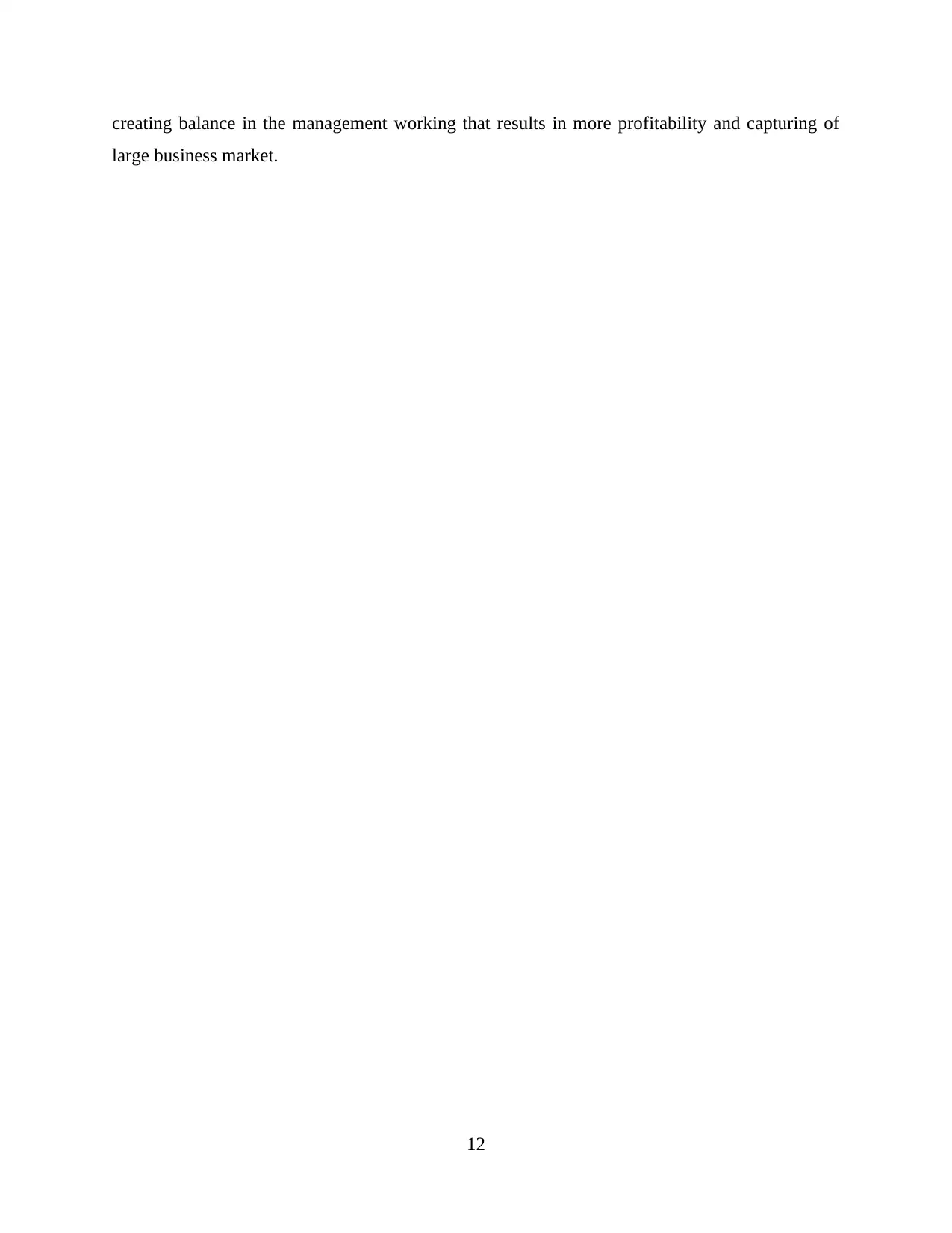
creating balance in the management working that results in more profitability and capturing of
large business market.
12
large business market.
12
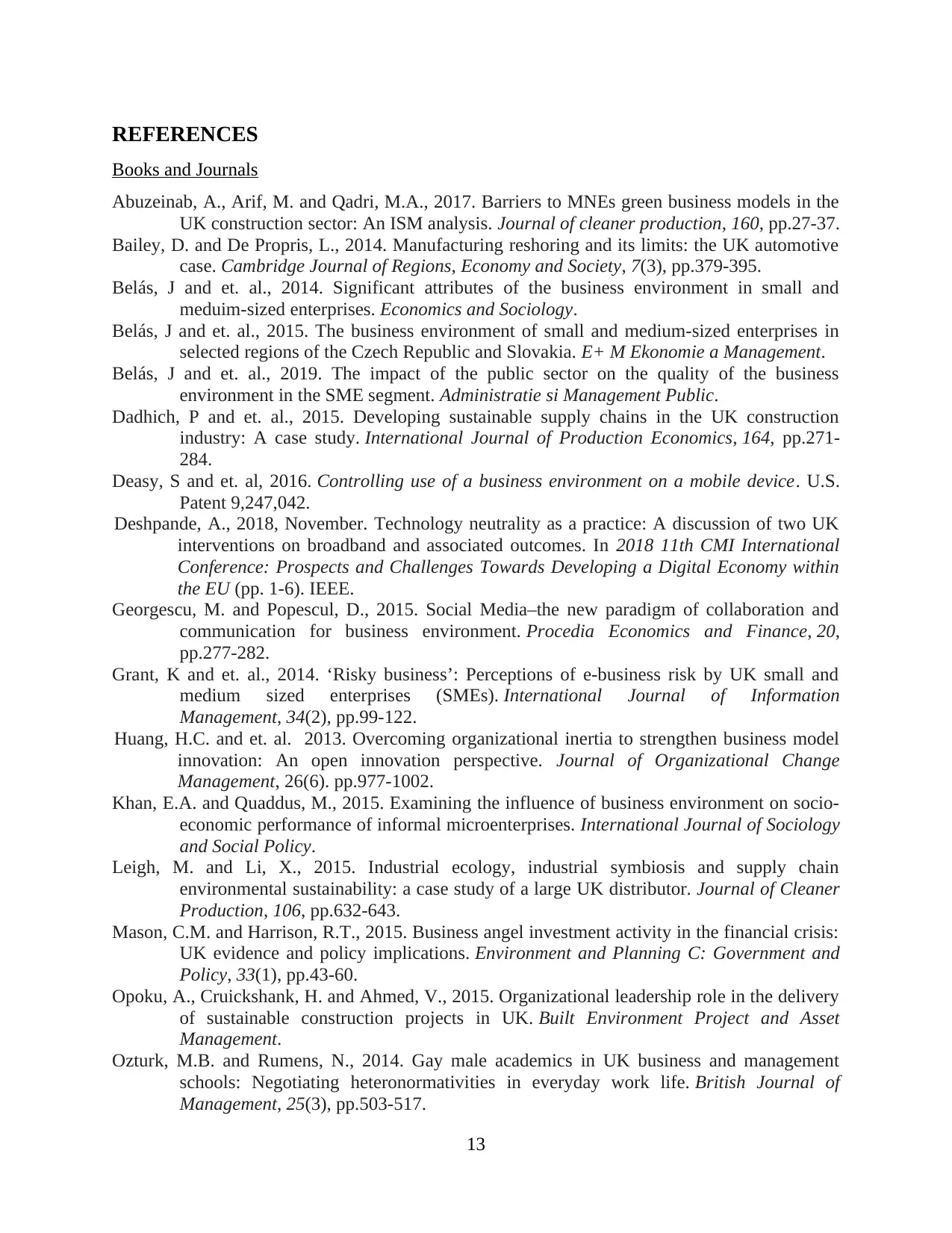
REFERENCES
Books and Journals
Abuzeinab, A., Arif, M. and Qadri, M.A., 2017. Barriers to MNEs green business models in the
UK construction sector: An ISM analysis. Journal of cleaner production, 160, pp.27-37.
Bailey, D. and De Propris, L., 2014. Manufacturing reshoring and its limits: the UK automotive
case. Cambridge Journal of Regions, Economy and Society, 7(3), pp.379-395.
Belás, J and et. al., 2014. Significant attributes of the business environment in small and
meduim-sized enterprises. Economics and Sociology.
Belás, J and et. al., 2015. The business environment of small and medium-sized enterprises in
selected regions of the Czech Republic and Slovakia. E+ M Ekonomie a Management.
Belás, J and et. al., 2019. The impact of the public sector on the quality of the business
environment in the SME segment. Administratie si Management Public.
Dadhich, P and et. al., 2015. Developing sustainable supply chains in the UK construction
industry: A case study. International Journal of Production Economics, 164, pp.271-
284.
Deasy, S and et. al, 2016. Controlling use of a business environment on a mobile device. U.S.
Patent 9,247,042.
Deshpande, A., 2018, November. Technology neutrality as a practice: A discussion of two UK
interventions on broadband and associated outcomes. In 2018 11th CMI International
Conference: Prospects and Challenges Towards Developing a Digital Economy within
the EU (pp. 1-6). IEEE.
Georgescu, M. and Popescul, D., 2015. Social Media–the new paradigm of collaboration and
communication for business environment. Procedia Economics and Finance, 20,
pp.277-282.
Grant, K and et. al., 2014. ‘Risky business’: Perceptions of e-business risk by UK small and
medium sized enterprises (SMEs). International Journal of Information
Management, 34(2), pp.99-122.
Huang, H.C. and et. al. 2013. Overcoming organizational inertia to strengthen business model
innovation: An open innovation perspective. Journal of Organizational Change
Management, 26(6). pp.977-1002.
Khan, E.A. and Quaddus, M., 2015. Examining the influence of business environment on socio-
economic performance of informal microenterprises. International Journal of Sociology
and Social Policy.
Leigh, M. and Li, X., 2015. Industrial ecology, industrial symbiosis and supply chain
environmental sustainability: a case study of a large UK distributor. Journal of Cleaner
Production, 106, pp.632-643.
Mason, C.M. and Harrison, R.T., 2015. Business angel investment activity in the financial crisis:
UK evidence and policy implications. Environment and Planning C: Government and
Policy, 33(1), pp.43-60.
Opoku, A., Cruickshank, H. and Ahmed, V., 2015. Organizational leadership role in the delivery
of sustainable construction projects in UK. Built Environment Project and Asset
Management.
Ozturk, M.B. and Rumens, N., 2014. Gay male academics in UK business and management
schools: Negotiating heteronormativities in everyday work life. British Journal of
Management, 25(3), pp.503-517.
13
Books and Journals
Abuzeinab, A., Arif, M. and Qadri, M.A., 2017. Barriers to MNEs green business models in the
UK construction sector: An ISM analysis. Journal of cleaner production, 160, pp.27-37.
Bailey, D. and De Propris, L., 2014. Manufacturing reshoring and its limits: the UK automotive
case. Cambridge Journal of Regions, Economy and Society, 7(3), pp.379-395.
Belás, J and et. al., 2014. Significant attributes of the business environment in small and
meduim-sized enterprises. Economics and Sociology.
Belás, J and et. al., 2015. The business environment of small and medium-sized enterprises in
selected regions of the Czech Republic and Slovakia. E+ M Ekonomie a Management.
Belás, J and et. al., 2019. The impact of the public sector on the quality of the business
environment in the SME segment. Administratie si Management Public.
Dadhich, P and et. al., 2015. Developing sustainable supply chains in the UK construction
industry: A case study. International Journal of Production Economics, 164, pp.271-
284.
Deasy, S and et. al, 2016. Controlling use of a business environment on a mobile device. U.S.
Patent 9,247,042.
Deshpande, A., 2018, November. Technology neutrality as a practice: A discussion of two UK
interventions on broadband and associated outcomes. In 2018 11th CMI International
Conference: Prospects and Challenges Towards Developing a Digital Economy within
the EU (pp. 1-6). IEEE.
Georgescu, M. and Popescul, D., 2015. Social Media–the new paradigm of collaboration and
communication for business environment. Procedia Economics and Finance, 20,
pp.277-282.
Grant, K and et. al., 2014. ‘Risky business’: Perceptions of e-business risk by UK small and
medium sized enterprises (SMEs). International Journal of Information
Management, 34(2), pp.99-122.
Huang, H.C. and et. al. 2013. Overcoming organizational inertia to strengthen business model
innovation: An open innovation perspective. Journal of Organizational Change
Management, 26(6). pp.977-1002.
Khan, E.A. and Quaddus, M., 2015. Examining the influence of business environment on socio-
economic performance of informal microenterprises. International Journal of Sociology
and Social Policy.
Leigh, M. and Li, X., 2015. Industrial ecology, industrial symbiosis and supply chain
environmental sustainability: a case study of a large UK distributor. Journal of Cleaner
Production, 106, pp.632-643.
Mason, C.M. and Harrison, R.T., 2015. Business angel investment activity in the financial crisis:
UK evidence and policy implications. Environment and Planning C: Government and
Policy, 33(1), pp.43-60.
Opoku, A., Cruickshank, H. and Ahmed, V., 2015. Organizational leadership role in the delivery
of sustainable construction projects in UK. Built Environment Project and Asset
Management.
Ozturk, M.B. and Rumens, N., 2014. Gay male academics in UK business and management
schools: Negotiating heteronormativities in everyday work life. British Journal of
Management, 25(3), pp.503-517.
13

Sung, K and et. al., 2017. Challenges and support for scaling up upcycling businesses in the UK:
Insights from small-business entrepreneurs. IOS Press.
Online
Analysing The Organisational Structure. 2019. [Online] Available
through<https://www.ukessays.com/essays/business/analysing-the-organizational-
structure-of-syngenta.php>./
14
Insights from small-business entrepreneurs. IOS Press.
Online
Analysing The Organisational Structure. 2019. [Online] Available
through<https://www.ukessays.com/essays/business/analysing-the-organizational-
structure-of-syngenta.php>./
14
1 out of 16
Related Documents
Your All-in-One AI-Powered Toolkit for Academic Success.
+13062052269
info@desklib.com
Available 24*7 on WhatsApp / Email
![[object Object]](/_next/static/media/star-bottom.7253800d.svg)
Unlock your academic potential
© 2024 | Zucol Services PVT LTD | All rights reserved.





